MCQs for Physics Class 11 with Answers Chapter 3 Motion in a Straight Line
Students of class 11 Physics should refer to MCQ Questions Class 11 Physics Motion in a Straight Line with answers provided here which is an important chapter in Class 11 Physics NCERT textbook. These MCQ for Class 11 Physics with Answers have been prepared based on the latest CBSE and NCERT syllabus and examination guidelines for Class 11 Physics. The following MCQs can help you to practice and get better marks in the upcoming class 11 Physics examination
Chapter 3 Motion in a Straight Line MCQ with Answers Class 11 Physics
MCQ Questions Class 11 Physics Motion in a Straight Line provided below have been prepared by expert teachers of grade 11. These objective questions with solutions are expected to come in the upcoming Standard 11 examinations. Learn the below provided MCQ questions to get better marks in examinations.
Question. A body moves in a straight line along Y-axis. Its distance y (in metre) from the origin is given by y = 8t – 3t2. The average speed in the time interval from t = 0 second to t = 1 second is
(a) – 4 ms–1
(b) zero
(c) 5 ms–1
(d) 6 ms–1
Answer
C
Question. The displacement of a particle is given by x = (t – 2)2 where x is in metre and t in second. The distance covered by the particle in first 4 seconds is
(a) 4 m
(b) 8 m
(c) 12 m
(d) 16 m
Answer
B
Question. At a metro station, a girl walks up a stationary escalator in time t1. If she remains stationary on the escalator, then the escalator take her up in time t2. The time taken by her to walk up on the moving escalator will be

Answer
C
Question. The acceleration due to gravity on planet A is nine times the acceleration due to gravity on planet B. A man jumps to a height 2m on the surface of A. What is height of jump by same person on planet B?
(a) 2/3 m
(b) 2/9 m
(c) 18 m
(d) 6 m
Answer
C
Question. In the given figure the distance PQ is constant. SQ is a vertical line passing through point R. A particle is kept at R and the plane PR is such that angle θ can be varied such that R lies on line SQ. The time taken by particle to come down varies, as the θ increase

(a) decreases continuously
(b) increases
(c) increases then decreases
(d) decreases then increases
Answer
D
Question. The displacement x of a particle varies with time t as x = ae-at + bebt, where a, b, a and b are positive constants. The velocity of the particle will
(a) be independent of a and β
(b) drop to zero when a = β
(c) go on decreasing with time
(d) go on increasing with time
Answer
D
Question. Which one of the following equations represents the motion of a body with finite constant acceleration ? In these equations, y denotes the displacement of the body at time t and a, b and c are constants of motion.
(a) y = at
(b) y = at + bt2
(c) y = at + bt2 + ct3
(d) y = (a/t) + bt
Answer
B
Question. The dependence of velocity of a body with time is given by the equation v = 20 + 0.1t2. The body is in
(a) uniform retardation
(b) uniform acceleration
(c) non-uniform acceleration
(d) zero acceleration.
Answer
C
Question. Two stones are thrown from the top of a tower, one straight down with an initial speed u and the second straight up with the same speed u. When the two stones hit the ground, they will have speeds in the ratio
(a) 2 : 3
(b) 2 : 1
(c) 1 : 2
(d) 1 : 1
Answer
D
Question. A graph of acceleration versus time of a particle starting from rest at t = 0 is as shown in Fig. The speed of the particle at t = 14 second is

(a) 2 ms–1
(b) 34 ms–1
(c) 20 ms–1
(d) 42 ms–1
Answer
B
Question. The displacement x of a particle along a straight line at time t is given by : x = a0 +(a1t/2)+(a2/3)t2. The acceleration of the particle is
(a) a2/3
(b) 2a2/3
(c) a1/3
(d) a0+/a2/3
Answer
B
Question. In the displacement d versus time t graph given below, the value of average velocity in the time interval 0 to 20 s is (in m/s)

(a) 1.5
(b) 4
(c) 1
(d) 2
Answer
C
Question. A body starts from rest and travels a distance x with uniform acceleration, then it travels a distance 2x with uniform speed, finally it travels a distance 3x with uniform retardation and comes to rest. If the complete motion of the particle is along a straight line, then the ratio of its average velocity to maximum velocity is
(a) 2/5
(b) 3/5
(c) 4/5
(d) 6/7
Answer
B
Question. The displacement ‘x’ (in meter) of a particle of mass ‘m’ (in kg) moving in one dimension under the action of a force, is related to time ‘t’ (in sec) by t =√ x + 3 . The displacement of the particle when its velocity is zero, will be
(a) 2 m
(b) 4 m
(c) zero
(d) 6 m
Answer
C
Question. A ball is thrown vertically upward with a velocity ‘u’ from the balloon descending with velocity v. The ball will pass by the balloon after time

Answer
D
Question. A particle of unit mass undergoes one-dimensional motion such that its velocity varies according to v(x) = bx–2n where b and n are constants and x is the position of the particle. The acceleration of the particle as d function of x, is given by:
(a) –2nb2x–4n–1
(b) –2b2x–2n+1
(c) –2nb2e–4n+1
(d) –2nb2x–2n–1
Answer
A
Question. Two bodies begin a free fall from the same height at a time interval of N s. If vertical separation between the two bodies is 1 after n second from the start of the first body, then n is equal to

Answer
C
Question. A lift is coming from 8th floor and is just about to reach 4th floor. Taking ground floor as origin and positive direction upwards for all quantities, which one of the following is correct?
(a) x < 0, v < 0, a > 0
(b) x > 0, v < 0, a < 0
(c) x > 0, v < 0, a > 0
(d) x > 0, v > 0, a < 0
Answer
A
Question. For the velocity time graph shown in the figure below the distance covered by the body in the last two seconds of its motion is what fraction of the total distance travelled by it in all the seven seconds?

(a) 1/5
(b) 1/4
(c) 2/3
(d) 1/3
Answer
B
Question. A balloon starts rising from the ground with an acceleration of 1.25 ms–2. After 8 s, a stone is released from the balloon. The stone will (Taking g = 10 m s–2)
(a) begin to move down after being released
(b) reach the ground in 4 s
(c) cover a distance of 40 m in reaching the ground
(d) will have a displacement of 50 m.
Answer
B
Question. A point initially at rest moves along x-axis. Its acceleration varies with time as a = (6t + 5)m / s2 . If it starts from origin, the distance covered in 2 s is
(a) 20 m
(b) 18 m
(c) 16 m
(d) 25 m
Answer
B
Question. A particle moves a distance x in time t according to equation x = (t + 5)–1. The acceleration of particle is proportional to
(a) (velocity) 3/2
(b) (distance)2
(c) (distance)–2
(d) (velocity)2/3
Answer
A
Question. If a ball is thrown vertically upwards with a velocity of 40m/s, then velocity of the ball after two seconds is :
(g = 10 m/sec2)
(a) 15 m/s
(b) 20 m/s
(c) 25 m/s
(d) 28 m/s
Answer
B
Question. A steel ball is bouncing up and down on a steel plate with a period of oscillation of 1 second. If g = 10 ms–2, then it bounces up to a height of
(a) 5 m
(b) 10 m
(c) 2.5 m
(d) 1.25 m
Answer
D
Question. If a car at rest accelerates uniformly to a speed of 144 km/h in 20 sec., it covers a distance of
(a) 20 cm
(b) 400 m
(c) 1440 cm
(d) 2980 cm
Answer
B
Question. A boy starts from a point A, travels to a point B at a distance of 3 km from A and returns to A. If
he takes two hours to do so, his speed is
(a) 3 km/h
(b) zero
(c) 2 km/h
(d) 1.5 km/h
Answer
Question. The dimensional formula for speed is
(a) T-1
(b) LT-1
(c) L-1T-1
(d) L-1T
Answer
Question. A body starts from rest and travels with uniform acceleration a to make a displacement of 6 m. If its velocity after making the displacement is 6 m/s, then its uniform acceleration a is
(a) 6 m/s²
(b) 2 m/s²
(c) 3 m/s²
(d) 4 m/s²
Answer
C
Question. A body starts from rest and travels for t second with uniform acceleration of 2 m/s². If the displacement made by it is 16 m, the time of travel t is
(a) 4 s
(b) 3 s
(c) 6 s
(d) 8 s
Answer
B
Question. Which one of the following is the unit of acceleration?
(a) m/s
(b) m/s²
(c) km/hr
(d) cm/s
Answer
B
Question. The dimensional formula for acceleration is
(a) [LT2]
(b) [LT?2]
(c) [L2T]
(d) [L2T2]
Answer
B
Question. A body starts from rest and travels with an acceleration of 2 m/s². After t seconds its velocity is 10 m/s. Then t is
(a) 10 s
(b) 5 s
(c) 20 s
(d) 6 s
Answer
B
Question. A body starts from rest and travels for five seconds to make a displacement of 25 m .if it has travelled the distance with uniform acceleration a then a is
(a) 3 m/s²
(b) 4 m/s²
(c) 2 m/s²
(d) 1 m/s²
Answer
C
Question. The dimensional formula for velocity is
(a) [LT]
(b) [LT-1]
(c) [L2T]
(d) [L-1T]
Answer
B
Question. A body starts from rest and travels with uniform acceleration on a straight line . If its velocity after making a displacement of 32 m is 8 m/s , its acceleration is
(a) 1 m/s²
(b) 2 m/s²
(c) 3 m/s²
(d) 4 m/s²
Answer
A
Question. A 180 metre long train is moving due north at a speed of 25 m/s. A small bird is flying due south, a little above the train, with a speed of 5 m/s. The time taken by the bird to cross the train is
(a) 10 s
(b) 12 s
(c) 9 s
(d) 6 s
Answer
D
Question. A body starts from rest and travels with uniform acceleration of 2 m/s². If its velocity is v after making a displacement of 9 m, then v is
(a) 8 m/s
(b) 6 m/s
(c) 10 m/s
(d) 4 m/s
Answer
B
Question. A boy starts from a point A, travels to a point B at a distance of 1.5 km and returns to A If he takes one hour to do so, his average velocity is
(a) 3 km/h
(b) zero
(c) 1.5 km/h
(d) 2 km/h
Answer
A
Question. A boy moves on a circular distance of radius R. Starting from a point A he moves to a point B which is on the other end of the diameter AB. The ratio of the distance travelled to the displacement made by him is
(a) Π/2
(b) Π
(c) 2Π
(d) 4Π
Answer
A
Question. Which one of the following is the unit of velocity?
(a) kilogram
(b) metre
(c) m/s
(d) second
Answer
C
Question. A boy starts from a point A, travels to a point B at a distance of 3 km from A and returns to A. If he takes two hours to do so, his speed is
(a) 3 km/h
(b) zero
(c) 2 km/h
(d) 1.5 km/h
Answer
A
Question. The position (x) of a particle moving along x-axis varies with time (t) as x = t2 – 8t + 3. The speed (v) versus time graph will be
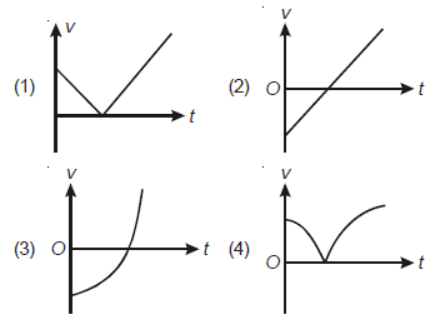
Answer
A
Question. A train ‘A’ moving with velocity 20 m/s approaches another train ‘B’ moving in the same direction on the same track, with velocity 10 m/s. If the maximum retardation that can be produced in the train A is 2 m/s2 on applying the brakes fully, what should be minimum separation between the two trains to avoid collision?
(a) 12.5 m
(b) 25 m
(c) 40 m
(d) 50 m
Answer
B
Question. A car accelerates from rest at 3 ms–2 and then retards to rest at 5 ms–2. The maximum velocity of the car is 30 ms–1, what is the distance covered by the car?
(a) 150 m
(b) 240 m
(c) 300 m
(d) 360 m
Answer
B
Question. A body projected vertically upward from the surface of earth is same height at t = 6 s and t = 11 s. The speed with which it is projected vertically upward is [Take g = 10 m/s2]
(a) 60 m/s
(b) 40 m/s
(c) 20 m/s
(d) 85 m/s
Answer
D
Question. A motor-boat can move with constant speed v in still water. It moves from point A to another point B in the downstream and comes back to the point A. Time taken in downstream journey is 10 minute and that in the upstream journey is 20 minute. The speed of the river flow is
(a) V/2
(b) V/3
(c) 3V/4
(d) 2V/5
Answer
B
Question. Displacement versus time curve of two particles P and Q are given. Calculate ratio of velocities of P and Q
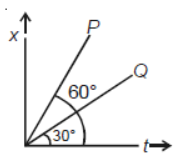
(a) 3/1
(b) 1/3
(c) 3/2
(d) 2/3
Answer
A
Question. A ball is projected with velocity v vertically upward from ground. It comes back and rebounds. Assume that collision is elastic, The curve between velocity and time is (take upward directions positive)
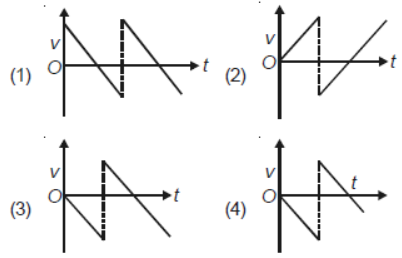
Answer
A
Question. A particle of mass m is released from rest from certain height H. It strikes the ground elastically.
What will be the graph between kinetic energy (K.E.) and time (t) till it returns to its initial position?

Answer
A
Question. Rain is pouring vertically downward with 10 km/h.
The velocity of the rain with respect to a man running toward north on a horizontal ground with 10 km/h is
(a) 10√2 km/h from north east
(b) 10√2 km/h from north west
(c) 10√2 km/h at 45° with the vertical toward south
(d) 10√2 km/h at 45° with the vertical towards north
Answer
C
Question. A particle is thrown with 50 m/s at an angle 60°above horizontal from the top of a tower. If g = 10 m/s2, then change in velocity of the body in first 5 s is
(a) 50 m/s vertically up
(b) 50 m/s vertically down
(c) 50√2 m/s at 45° below horizontal
(d) 50√2 m/s at 45° above horizontal
Answer
B
Question. The magnitude of resultant of two forces F1 and F2 each of magnitude 10 N as shown in figure is

Answer
C
Question. A fighter plane moving with velocity v horizontally drops a bomb from height H. The horizontal range at which bomb will strike the ground is
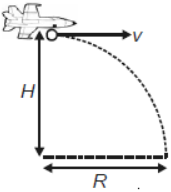
(a) 2H/g
(b) 2H/gv
(c) v√2H/g
(d) √H/2g
Answer
C
Question. A particle is thrown horizontally from the top of a tower of height H with velocity v. Time taken by it to hit the ground is T. If another particle is thrown horizontally from the same point with speed 2v, then time taken by it to reach the ground is
(a) T
(b) 2T
(c) T/2
(d) √2 T
Answer
A
Question. Acceleration time graph of a particle moving in a straight line is shown. Velocity of particle at t = 0 is 5 m/s. The velocity of the particle at the end of fourth second is
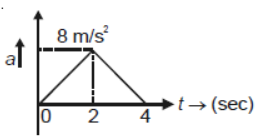
(a) 16 m/s
(b) 11 m/s
(c) 21 m/s
(d) 5 m/s
Answer
C
Question. A person walking on an escalator takes time t1 to reach at the top of tower when escalator is at rest.
If man is at rest and escalator moves then it takes t2 time to reach at top of tower. If both man and escalator move, then how much time will he take to reach at top?
(a) t2 – t1
(b) t1t2
(c) t2 – t1/t1t2
(d) t1t2 /t1 + t2
Answer
D

We hope the above multiple choice questions for Class 11 Physics for Chapter 3 Motion in a Straight Line provided above with answers based on the latest syllabus and examination guidelines issued by CBSE, NCERT and KVS are really useful for you. Motion in a Straight Line is an important chapter in Class 11 as it provides very strong understanding about this topic. Students should go through the answers provided for the MCQs after they have themselves solved the questions. All MCQs have been provided with four options for the students to solve. These questions are really useful for the benefits of class 11 students. Please go through these and let us know if you have any feedback in the comments section.
